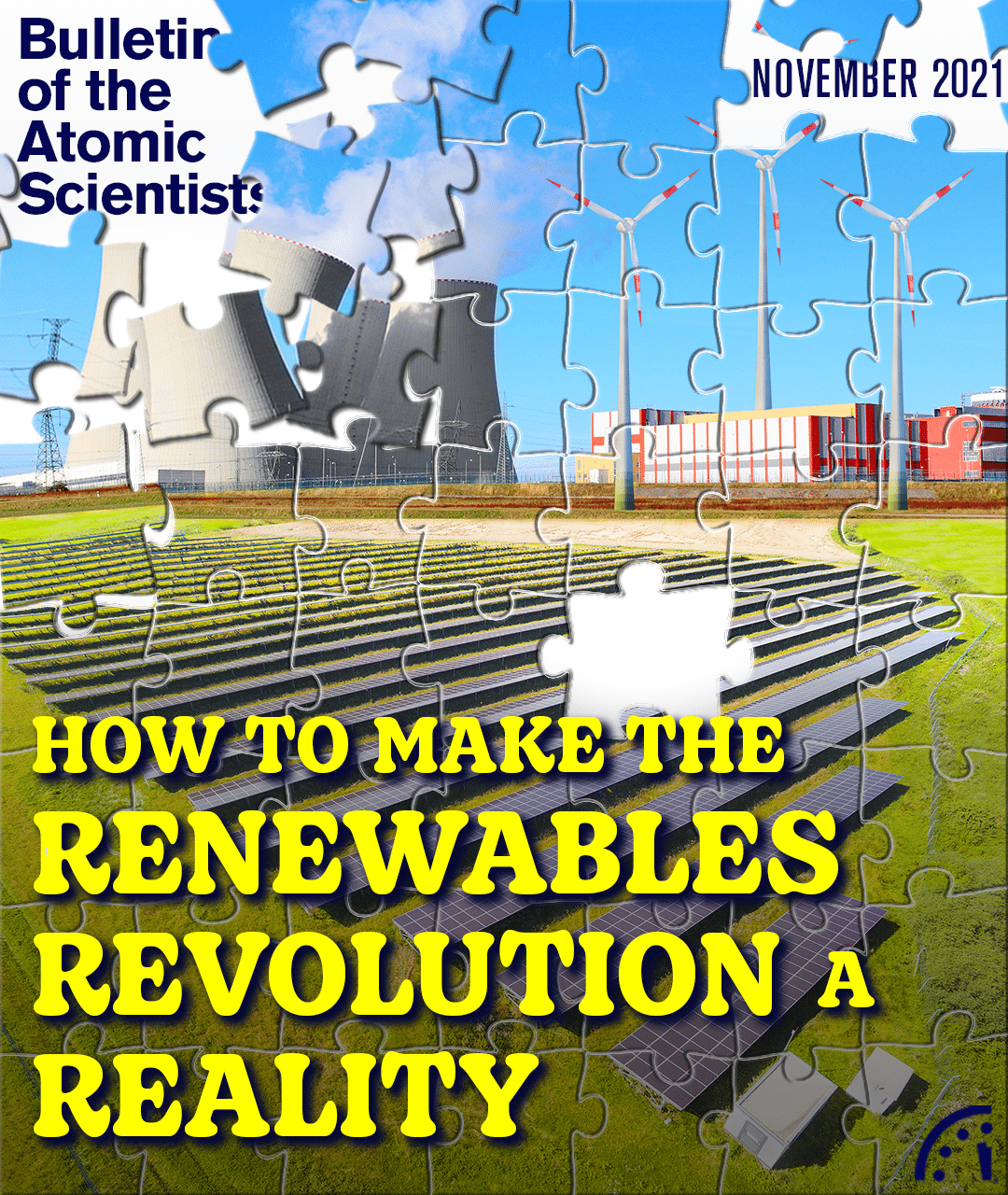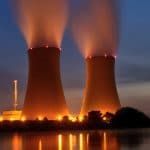How the renewables revolution can move from catchphrase to reality
By John Mecklin | November 15, 2021
How the renewables revolution can move from catchphrase to reality
By John Mecklin | November 15, 2021
As this issue of the Bulletin was published, the countries of the world had just finished meeting at COP 26[1] in Glasgow, Scotland, to put forward new targets for reductions in global greenhouse gas emissions, aiming to reach a global “net zero” level by mid-century. The meeting and the national commitments to be made there are important, if the world is to avert the worst effects of climate change. Even more important, though, are practical implementations of those commitments, so they actually create the massive, real-world transition of global energy systems needed to move the world away from fossil fuels and toward energy sources that do not emit carbon dioxide.
Making such a renewable energy revolution a reality will require the greatly increased use of solar and wind energy, both of which are intermittent in nature on daily and seasonal time scales. That’s to say, electrical systems based largely or entirely on solar and wind will need to provide electricity when the sun doesn’t shine and the wind doesn’t blow. For this issue, California Institute of Technology experts Jacqueline A. Dowling and Nathan S. Lewis explore the practical options for long-term storage that could be used to make 100 percent renewable electricity reliable and affordable. Their description of emerging systems that use excess solar and wind power to produce hydrogen, which can then be stored for months or even years in salt domes and other underground structures and used to generate electricity as needed, was particularly fascinating to me, and as hopeful as anything I’ve read in the climate space for quite some time.
Given the continuing debate over nuclear power and its place in the fight against climate change, and because this is after all the Bulletin of the Atomic Scientists, our November issue contains three articles on the subject.
On the pro-nuclear side of the debate, MIT climate scientist Kerry Emanuel notes that two countries—France and Sweden—have shown that “electrical power can be decarbonized in less than a dozen years with combinations of renewable and nuclear energy, but exaggerated fears of the latter have made it too costly and unpopular to develop and deploy in much of the world.” Robert Rosner and Sabrina Fields of the University of Chicago focus specifically on the economics of the Swedish model, showing, among other things, that in Sweden’s marketplace nuclear power is an effective competitor against renewable power generation.
But there are serious arguments against the possibility of nuclear power becoming a growing factor in the decarbonization of world energy systems. As Sharon Squassoni, a nuclear policy research professor at the George Washington University, notes, climate solutions need to be implemented quickly if the world is avoid climate catastrophe—and nuclear power has historically been anything but quick. “At its best, nuclear energy might provide some load-balancing ballast for renewable energies; at its worst, it will slow the transition to a net-zero emissions future and should therefore be trimmed from our set of options,” Squassoni writes. “Continuing to support nuclear energy at the expense of faster and cheaper alternatives for cutting greenhouse gas emissions is a losing strategy.”
If the US prospects for greatly increased use of nuclear power are at best unclear (and in the view of many, at least partly cloudy), one largely carbon-free source of American energy seems almost certain to experience sharp growth in coming decades: offshore wind. In an interview with Bulletin executive editor Dan Drollette Jr., Woods Hole Oceanographic Institution physicist Anthony Kirincich provides an engaging look at the many practical hurdles—from sea-bottom boulders to right whales and lightning strikes—that must be jumped, if thousands of wind turbines are to be installed quickly in the relatively shallow waters off the United States’ eastern seaboard. One example that Kirincich notes: Wind turbines are large machines, and you need somewhere to put them, on shore, before you install them off the coast. “I mean, you can find lay down space relatively easily when you’re dealing with only five windmills that need to be installed offshore—but can you do it for 5,000?” he asks. “Because that’s roughly the scale of the Biden administration goal.”
To wrap our renewables package, Drollette also interviewed Greg Nemet, the author of How Solar Became Cheap: A Model for Low Carbon Innovation, a professor at the University of Wisconsin-Madison, and a lead author for the Intergovernmental Panel on Climate Change 6th Assessment Report. Nemet lays out five basic attributes that will need to exist, if the US electrical system is eventually to support a net-zero carbon economy. The system will have to include: multiple renewable energy sources, to make up to some degree for the intermittence of solar and wind power; an expanded electrical transmission system to move electricity more effectively and efficiently; the electrical storage capacity needed to supply power during slack generation periods; a way to shift energy demand, so use comes at the times when solar and wind power are plentiful; and the digitized “smart” grid controls needed to tie all these elements into an elastic and reliable system “that allows grid operators to understand where there’s an outage or where there’s congestion.”
The practical changes needed for renewable energy to replace fossil fuels will be difficult to quickly institute in a wealthy and relatively democratic country like the United States. Enabling that kind of revolution on a global basis—in nations rich and poor, well and poorly led, and scientifically more and less advanced—is one of the overarching challenges of our times. A failure to make that revolution global will threaten everyone, and everyone’s children, and their children—and eventually world civilization writ large. Since failure is not a pleasant option, it seems time to look squarely at the practical steps that can be taken now—and to begin taking them, one after another. The journey, long and difficult as it may be, will lead to a place of safety, a world preserved.
Together, we make the world safer.
The Bulletin elevates expert voices above the noise. But as an independent nonprofit organization, our operations depend on the support of readers like you. Help us continue to deliver quality journalism that holds leaders accountable. Your support of our work at any level is important. In return, we promise our coverage will be understandable, influential, vigilant, solution-oriented, and fair-minded. Together we can make a difference.
Keywords: COP26, climate change, long-term electricity storage, nuclear energy, offshore wind, renewables revolution
Topics: Climate Change






















Very interested in this month’s premium content. Any way to purchase for less than the yearly subscription price?
Hey Alex,
Psssst. Right now, there’s no way to purchase individual articles — but keep your eye out on Thanksgiving for a Black Friday / Cyber Monday discount code….
Fossil fuels provide two functions [ https://www.sciencedirect.com/science/article/pii/S1040619021001330?via%3Dihub ]: (1) energy and (2) energy storage that enables providing variable energy as needed. The U.S. stores about 6 weeks of energy to function—slightly under four million gigawatt hours in the form of a 90 day supply of oil, a 30 day supply of natural gas, a 100+ day supply of coal and 9 to 12 months of nuclear fuel in reactors. In fossil systems, the cost of storage is very low. To replace just one million gigawatt hours with batteries would cost 500 trillion dollars or expanding pumped hydro storage by 1800.There are only… Read more »
Renewables are now reality, not a “catchphrase”.
Renewables (excluding hydro) supplied more electricity (3147 TWh) to the world in 2020 than nuclear power (2700 TWh) according to BP.
The power systems can handle a lot more wind and solar even without storage.